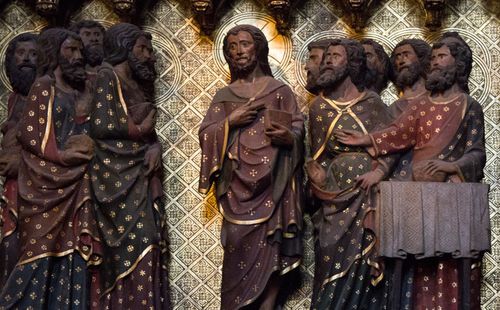
Beloved Members of St. Martin’s,
This Sunday’s readings have contained many words of comfort and strength for me in the last few days. We have had two of our beloved parishioners pass into glory this week, and I and my mother and sister have been dealing with the death of my younger brother. Meditating upon verses such as Psalm 4:6-8 speaks directly to the trouble and doubts that plague us when we experience trauma and loss. I commend these words to you for comfort and assurance in times such as these:
Many are saying, "Oh, that we might see better times!"
Lift up the light of your countenance upon us, O LORD.
You have put gladness in my heart,
more than when grain and wine and oil increase.
I lie down in peace; at once I fall asleep;
for only you, LORD, make me dwell in safety.
All four of our readings this weekend speak to a lack of belief in response to being involved in pain and loss. Our gospel passage, from Luke 24, comes from the final chapter in the gospel of Luke. It starts with the women appearing at the tomb to help preserve Jesus’s body with spice, only to find that the tomb is empty and the stone has been rolled back. There they encounter two angels who tell them that the one whom they seek is not there (Luke 24:1-7). They then went back to the eleven remaining apostles and tell them what they see, but are not believed (vv. 8-11). Peter then runs to the tomb himself, and finds it empty (v. 12). This scene is immediately followed (vv. 13-13-35) by the encounter on the road to Emmaus. The two unnamed disciples in that tale once again go to the apostles and tell them that they have seen Jesus—and once again they are not believed. We then see then, today, Luke’s version of the events we hear last week: where Jesus suddenly appears to all the apostles gathered together.
Jesus’s first words, just as we saw in the gospel of John, is to bless his disciples and friends with peace (v. 36), and just like in the portion of John’s gospel that we heard last week, this is in response to their fear, their swirling emotions, and their doubt that erupts as a result. This response is natural and human—there is a reason why “I can’t believe it” is often our first response to shocking news like the loss of loved ones.
Jesus then commands those present to look at him- to truly see him, and to know that he is real (vv. 36-40). Of course, the first tendency is to think that they are looking at a ghost. Yet Jesus eating and drinking (v. 43) is meant to underscore that this is a living, breathing Christ that they encounter—ghosts have no need for food or drink. This also directly addresses the doubts of those who attempted to understand Jesus as never being fully human—disagreement s of which have continued in Christianity to this present day. Passages such as these underscore the humanity of Jesus, risen and fully alive, hungry and thirsty, bearing scars in his crucified, yet living body as signs of his survival and triumph over the grave.
This has important implications for all of us experiencing loss—if Jesus had a bodily resurrection, then we can anticipate the same thing for ourselves. If, as some claimed, Jesus was only a spirit in the shape of a human body, then Jesus’s ability to understand the human condition and bring it into the experience of the divine would be greatly limited. No, Jesus being both fully human and fully divine was a necessary precondition for our salvation throughout Christian theology to today. This is why you are encouraged to cross yourself at the words of the Nicene Creed as we affirm our faith :in the resurrection of the dead and the life everlasting.” Seeing the doubt of Jesus’s disciples and friends—and hearing Jesus’s words to be at peace and believe in his being with us in life as well as death-- helps us as we move from shock toward acceptance and faith that, in the words of the preface for the Eucharist at a Burial service (Book of Common Prayer, p. 382):
For to your faithful people, O Lord, life is changed, not ended…
That knowledge, and assurance, brings peace, for the disciples then and us as disciples now, indeed.
In Christ,
Mother Leslie+